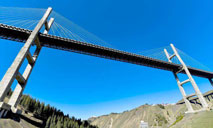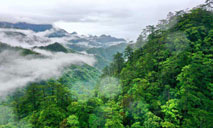Fusion of science, art to illustrate sci-tech innovations
BEIJING, May 26 (Xinhua) -- Scientific visualization, a service that produces illustrations and animations for academic papers, has played an important role as more and more Chinese researchers publish their breakthroughs in international journals.
Han Ying, one of the pioneers in this field in China, was tasked with finding illustrators for a book on alien invasive species in 2007. Back then, she was working with the China Academy of Agricultural Sciences.
"It was extremely challenging to tell an advertising designer how to draw desert locust or water hyacinth. I had to spend hours explaining the detail and got something far from my satisfaction," Han said. Thus, she decided to take matters into her own hands.
As a postgraduate student in plant protection at China Agricultural University, Han had opted for insect taxonomy as a compulsory module and learned basic skills of illustrations. Using the learnings from that course, she and one of her classmates drew out all the illustrations for the book by themselves.
This made Han realize the growing need for illustrations by scientific researchers as well as a dearth of such illustrators.
"There has been a growing trend of visualization in the scientific publishing industry. Researchers not only need simple charts, but also vivid illustrations to publish their papers in international journals. But they can seldom do it by themselves," Han said.
In 2007, she started a workshop in Beijing, which later burgeoned to become the Beijing Sondii Technology, a major service provider of scientific visualization in China.
Initially, Han employed designers with a science background like herself as she thought they would be able to understand the specific needs of scientists in various fields. However, she gradually noticed that such designers had limitations in aesthetic value.
"For example, most science students, including myself, would draw carbon atoms in black and gray, which is accurate but less imaginative. It is typical linear thinking," said Han, adding that illustration is a piece of artwork that requires more divergent imaginations from artists.
The company eventually began to employ more and more professional artists from the fields of fine arts, graphic design and animation design. They are offered training in basic science courses before they can start doing the illustration work.
"We have a team of science graduates, who form the academic group, to bridge the gap between our illustrators and scientists. They can delineate the demand of scientists to the illustrators, and work together to produce accurate illustration with high aesthetic standards," said Han.
So far, the company has provided individuals, institutions and enterprises more than 10,000 pieces of illustrations, images and animations, which were published in academic journals such as Cell, Nature and Science.
The company has more than 100 corporate clients, with the number continuing to increase. As Chinese enterprises have put more resources into research and development, they need visualization services for patent applications, bidding and public communication at home and abroad, Han noted.
Since more and more Chinese scientists have published their breakthroughs, these journals started to pick their papers as cover stories and asked the writers to provide cover images.
"Unlike academic paper illustrations, which are more specific, cover images are more symbolic and artistic as they are meant to attract readers' attention and persuade them to read the journal," said Zhao Hui, a veteran illustrator and the director of the company's design department.
In July 2018, a research report titled "Friction of Ionic Liquid-Glycol Ether Mixtures at Titanium Interfaces: Negative Load Dependence" was accepted as the cover story in Advanced Materials Interfaces.
The research studied a flat reoriented structure that produces a new sliding interface with lower friction at higher loads. Zhao was inspired by the description and used lotus leaves to symbolize the sliding interface in the journal's front cover.
Illustrators have their individual styles. Some prefer 3D modeling, others like Chinese ink landscape painting, traditional folk arts such as paper cutting, or fairy tale figures like Sun Wukong the monkey king.
"We don't set boundaries as long as the cover image is properly matched with the content, easy to understand by readers, and the journal editor can accept its artistic style," said Zhao.
To meet the growing demand for scientific visualization, Han Ying initiated training courses in 2013 to teach researchers how to use graphics software such as Photoshop, Illustrator and Maya to produce illustrations by themselves.
As of now, more than 7,500 researchers have attended these training courses. They come from institutions affiliated with the Chinese Academy of Sciences as well as universities and research and development departments of hi-tech companies.
The company also launched its graphics database for researchers to download and use items in their illustrations. The database includes images and models of basic elements in science research, such as protein structure, double-helix DNA molecule, and footballene.
"Our job is a fusion of science and art. We are proud that we can play a role in the scientific development of China and the world," said Han.
Photos
Related Stories
- Interview: Opening of China's FAST telescope to int'l scientists enhances collaboration, says Australian astrophysicist
- Highlights of China's science news
- China's achievement in technological innovation
- China makes new breakthrough in heavy-lift carrier rocket engine
- Astronomers release giant 2D map of universe
Copyright © 2021 People's Daily Online. All Rights Reserved.










